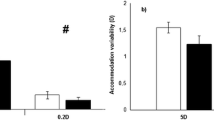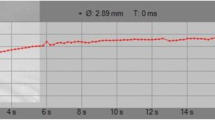Abstract
Background
There are claims that ocular accommodation differs in children with attention deficit hyperactivity disorder (ADHD) compared to typically developing children. We examined whether the accommodation response in ADHD children is influenced by changing the stimulus to accommodation in an attempt modify the level of attentional engagement or by medication for the condition.
Methods
We measured the accommodative response and pupil diameter using a binocular, open-field autorefractor in non-medicated and medicated children with ADHD (n = 22, mean age = 10.1 ± 2.4 years; n = 19; mean age = 11.0 ± 3.8 years; respectively) and in an age-matched control group (n = 22; mean age = 10.6 ± 1.9 years) while participants were asked to maintain focus on (i) a high-contrast Maltese cross, (ii) a frame of a cartoon movie (picture) and (iii) a cartoon movie chosen by the participant. Each stimulus was viewed for 180 s from a distance of 25 cm, and the order of presentation was randomised.
Results
Greater lags of accommodation were present in the non-medicated ADHD in comparison to controls (p = 0.023, lags of 1.10 ± 0.56 D and 0.72 ± 0.57 D, respectively). No statistically significant difference in the mean accommodative lag was observed between medicated ADHD children (lag of 1.00 ± 0.44D) and controls (p = 0.104) or between medicated and non-medicated children with ADHD (p = 0.504). The visual stimulus did not influence the lag of accommodation (p = 0.491), and there were no significant group-by-stimulus interactions (p = 0.935). The variability of accommodation differed depending on the visual stimulus, with higher variability for the picture condition compared to the cartoon-movie (p < 0.001) and the Maltese cross (p = 0.006). In addition, the variability yielded statistically significant difference for the main effect of time-on-task (p = 0.027), exhibiting a higher variability over time. However, no group differences in accommodation variability were observed (p = 0.935).
Conclusions
Children with ADHD have a reduced accommodative response, which is not influenced by the stimulus to accommodation. There is no marked effect of medication for ADHD on accommodation accuracy.



Similar content being viewed by others
References
Scheiman M, Wick B (2008) Clinical management of binocular vision: heterophoric, accommodative, and eye movement disorders, 3rd edn. Lippincott Williams & Wilkins, Philadelphia
Piast M, Kustrzeba-Wójcicka I, Matusiewicz M, Banaś T (2003) A review of electrophysiology in attention-deficit/hyperactivity disorder: II. Event-related potentials. Clin Neurophysiol 114:184–198. https://doi.org/10.1016/s1388-2457(02)00363-2
Coulter RA, Shallo-Hoffmann J (2000) The presumed influence of attention on accuracy in the developmental eye movement (DEM) test. Optom Vis Sci 77:428–432
Börger N, van der Meere J (2000) Visual behaviour of ADHD children during an attention test: an almost forgotten variable. J Child Psychol Psychiatry Allied Discip 41:525–532
Yeshurun Y, Carrasco M (1998) Attention improves or impairs visual performance by enhancing spatial resolution. Nature 396(6706):72–75
Ishikawa M, Yoshimura M, Sato H, Itakura S (2019) Effects of attentional behaviours on infant visual preferences and object choice. Cogn Process. https://doi.org/10.1007/s10339-019-00918-x
Polanczyk G, De Lima MS, Horta BL et al (2007) The worldwide prevalence of ADHD: a systematic review and metaregression analysis. Am J Psychiatry 164:942–948. https://doi.org/10.1176/appi.ajp.164.6.942
American Psychiatric Association (2013) Diagnostic and statistical manual of mental disorders, 5th edn. American Psychiatric Association, Washington, DC
Akmatov MK, Ermakova T, Bätzing J (2019) Psychiatric and nonpsychiatric comorbidities among children with ADHD: an exploratory analysis of nationwide claims data in Germany. J Atten Disord 108705471986577. https://doi.org/10.1177/1087054719865779
Rommelse N, Stigchel S, Sergeant J (2008) A review on eye movement studies in childhood and adolescent psychiatry. Brain Cogn 68:391–414. https://doi.org/10.1016/j.bandc.2008.08.025
Puig M, Zapata L, Puigcerver L, Iglesias NE (2015) Attention-related eye vergence measured in children with attention deficit hyperactivity disorder. PLoS One:1–16. https://doi.org/10.1371/journal.pone.0145281
Lenz D, Krauel K, Flechtner H et al (2010) Neuropsychologia altered evoked gamma-band responses reveal impaired early visual processing in ADHD children. Neuropsychologia 48:1985–1993. https://doi.org/10.1016/j.neuropsychologia.2010.03.019
Kim S, Banaschewski T, Tannock R (2014) Color vision in attention-deficit / hyperactivity disorder: a pilot visual evoked potential study. J Optom 8:116–130. https://doi.org/10.1016/j.optom.2014.10.002
Redondo B, Vera J, Molina R, García JA, Ouadi M, Muñoz-Hoyos A, Jiménez R (2018) Attention-deficit/hyperactivity disorder children exhibit an impaired accommodative response. Graefes Arch Clin Exp Ophthalmol 256(5):1023–1030
Lawson ML, Crewther SG, Junghans BM, Crewther DP, Kiely PM (2005) Changes in ocular accommodation when shifting between global and local attention. Clin Exp Optom 88:28–32
Davies LN, Wolffsohn JS, Gilmartin B (2005) Cognition, ocular accommodation, and cardiovascular function in emmetropes and late-onset myopes. Investig Ophthalmol Vis Sci 46:1791–1796. https://doi.org/10.1167/iovs.04-0986
Rosenfield M, Ciuffreda KJ (1990) Proximal and cognitively-induced accommodation. Ophthalmic Physiol Opt 10:252–256
Roberts TL, Manny RE, Benoit JS, Anderson HA (2018) Impact of cognitive demand during sustained near tasks in children and adults. Optom Vis Sci 95:223–233. https://doi.org/10.1097/OPX.0000000000001186
Woodhouse JM, Cregg M, Gunter HL et al (2000) The effect of age, size of target, and cognitive factors on accommodative responses of children with down syndrome. Investig Ophthalmol Vis Sci 41:2479–2485
Anketell PM, Saunders KJ, Gallagher SM, Bailey C (2018) Accommodative function in individuals with autism spectrum disorder. Optom Vis Sci 95:193–201. https://doi.org/10.1097/OPX.0000000000001190
Gaggi O, Ciman M (2016) The use of games to help children eyes testing. Multimed Tools Appl 75:3453–3478. https://doi.org/10.1007/s11042-014-2444-x
Aslam TM, Rahman W, Henson DKP (2011) A novel paediatric game-based visual-fields assessor. Br J Ophthalmol 95:921–924
Wang Y, Ali Z, Subramani S et al (2017) Normal threshold size of stimuli in children using a game-based visual field test. Ophthalmol Therapy 6:115–122. https://doi.org/10.1007/s40123-016-0071-5
Anderson HA, Glasser A, Manny RE, Stuebing KK (2010) Age-related changes in accommodative dynamics from preschool to adulthood. Investig Ophthalmol Vis Sci 51:614–622. https://doi.org/10.1167/iovs.09-3653
Greenhill L (2001) Clinical effects of stimulant medication in ADHD. In: Solanto MV, Arnsten AFT, Castellanos FX (eds) Stimulant drugs and ADHD: basic and clinical neuroscience. Oxford University Press, NewYork
Arnsten AF (2006) Stimulants: therapeutic actions in ADHD. Neuropsychopharmacology 31:2376
Molina-Carballo A, Checa-Ros A, Muñoz-Hoyos A (2016) Treatments and compositions for attention deficit hyperactivity disorder: a patent review. Expert Opin Ther Pat 26:799–814. https://doi.org/10.1080/13543776.2016.1182989
Fried M, Tsitsiashvili E, Bonneh YS et al (2014) ADHD subjects fail to suppress eye blinks and microsaccades while anticipating visual stimuli but recover with medication. Vis Res 101:62–72. https://doi.org/10.1016/j.visres.2014.05.004
Klein CH, Raschke A, Brandenbusch A (2003) Development of pro- and antisaccades in children with attention-deficit hyperactivity disorder (ADHD) and healthy controls. Psychophysiology 40:17–28
Martin L, Aring E, Landgren M et al (2008) Visual fields in children with attention-deficit/hyperactivity disorder before and after treatment with stimulants. Acta Ophthalmol 86:259–264. https://doi.org/10.1111/j.1755-3768.2008.01189.x
Whitman BY, Lindsay RL, Cruz OAP (1997) The effect of ritalin (methylphenidate) on visual acuity of children treated for attention- deficit/hyperactivity disorder. Pediatr Res 41:100
Grönlund MA, Aring E, Landgren M, Hellström A (2007) Visual function and ocular features in children and adolescents with attention deficit hyperactivity disorder, with and without treatment with stimulants. Eye 21:494–502. https://doi.org/10.1038/sj.eye.6702240
Wechsler D (1974) Manual for the Wechsler intelligence scale for children, revised. Psychological Corporation, New York
Kulp MT, Ciner E, Maguire M et al (2017) Attention and visual motor integration in young children with uncorrected hyperopia. Optom Vis Sci 94:1. https://doi.org/10.1097/OPX.0000000000001123
Charman WN, Tucker J (1977) Dependence of accommodation response on the spatial frequency spectrum of the observed object. Vis Res 17:129–139
Sheppard AL, Davies LN (2010) Clinical evaluation of the Grand Seiko Auto Ref/Keratometer WAM-5500. Ophthalmic Physiol Opt 30:143–151. https://doi.org/10.1111/j.1475-1313.2009.00701.x
Wang Y, Bao J, Ou L et al (2013) Reading behavior of emmetropic schoolchildren in China. Vis Res 86:43–51. https://doi.org/10.1016/j.visres.2013.03.007
Momeni-Moghaddam H, McAlinden C, Azimi A et al (2014) Comparing accommodative function between the dominant and non-dominant eye. Graefes Arch Clin Exp Ophthalmol 252:509–514. https://doi.org/10.1007/s00417-013-2480-7
Tosha C, Borsting E, Ridder WH, Chase C (2009) Accommodation response and visual discomfort. Ophthalmic Physiol Opt 29:625–633. https://doi.org/10.1111/j.1475-1313.2009.00687.x
Poltavski D, Biberdorf D, Petros T (2012) Accommodative response and cortical activity during sustained attention. Vis Res 63:1–8. https://doi.org/10.1016/j.visres.2012.04.017
Atchison DA, Varnas SR (2017) Accommodation stimulus and response determinations with autorefractors. Ophthalmic Physiol Opt 37:96–104. https://doi.org/10.1111/opo.12340
Hasebe S, Graf EW, Schor CM (2001) Fatigue reduces tonic accommodation. Ophthalmic Physiol Opt 21:151–160. https://doi.org/10.1046/j.1475-1313.2001.00558.x
Horwood AM, Riddell PM (2010) Differences between naïve and expert observers’ vergence and accommodative responses to a range of targets. Ophthalmic Physiol Opt 30:152–159. https://doi.org/10.1111/j.1475-1313.2009.00706.x
Sterner B, Gellerstedt M, Sjöström A (2006) Accommodation and the relationship to subjective symptoms with near work for young school children. Ophthalmic Physiol Opt 26:148–155. https://doi.org/10.1111/j.1475-1313.2006.00364.x
Borsting E, Rouse M, Chu R (2005) Measuring ADHD behaviors in children with symptomatic accommodative dysfunction or convergence insufficiency: a preliminary study. Optometry 76:588–592
Granet DB, Gomi CF, Ventura RE, Miller-Scholte A (2005) The relationship between convergence insufficiency and ADHD. Strabismus 13:163–168. https://doi.org/10.1080/09273970500455436
Jiménez R, Gonzalez MD, Pérez MA, García JA (2003) Evolution of accommodative function and development of ocular movements in children. Ophthalmic Physiol Opt 23:97–107
Charman WN, Heron G (2015) Microfluctuations in accommodation: an update on their characteristics and possible role. Ophthalmic Physiol Opt 35:476–499. https://doi.org/10.1111/opo.12234
Miller NR (1985) Walsh and Hoyt’s clinical neuro-ophthalmology. Williams & Wilkins, Baltimore
Unsworth N, Robison MK (2016) Pupillary correlates of lapses of sustained attention. Cogn Affect Behav Neurosci 16:601–615. https://doi.org/10.3758/s13415-016-0417-4
Donaghue KC, Pena MM, Fung ATW, Bonney M, Howard NJ, Silink M, Schwingshandl J (1995) The prospective assessment of autonomic nerve function by pupillometry in adolescents with type 1 diabetes mellitus. Diabet Med 12:868–873
Kara K, Karaman D, Erdem U et al (2013) Investigation of autonomic nervous system functions by pupillometry in children with attention deficit hyperactivity disorder. Klin Psikofarmakol Bülteni-Bulletin Clin Psychopharmacol 23:49–56. https://doi.org/10.5455/bcp.20121130085850
Wainstein G, Rojas-Líbano D, Crossley NA et al (2017) Pupil size tracks attentional performance in attention-deficit/hyperactivity disorder. Sci Rep 7:1–9. https://doi.org/10.1038/s41598-017-08246-w
Gray JD, Punsoni M, Tabori NE et al (2007) Methylphenidate administration to juvenile rats alters brain areas involved in cognition, motivated behaviors, appetite, and stress. J Neurosci 27:7196–7207. https://doi.org/10.1523/JNEUROSCI.0109-07.2007
Larrañaga-Fragoso P, Noval S, Rivero JC, Boto-De-Los-Bueis A (2015) The effects of methylphenidate on refraction and anterior segment parameters in children with attention deficit hyperactivity disorder. J AAPOS 19:322–326. https://doi.org/10.1016/j.jaapos.2015.04.005 https://www.ema.europa.eu/en/documents/referral/methylphenidate-article-31-referral-annex-i-ii-iii-iv_en.pdf
Suzuki Y (2007) The near response: the contributions of Kenji Ohtsuka, MD. J Neuroophthalmol 27:138–142
Lu C, Kuang T, Chou JC (2006) Methylphenidate (ritalin)-associated cataract and glaucoma. J Chin Med Assoc 69:589–590. https://doi.org/10.1016/S1726-4901(09)70335-1
Tobaiqy M, Helms PJ, Williams J et al (2011) Parental reporting of adverse drug reactions associated with attention-deficit hyperactivity disorder (ADHD) medications in children attending specialist paediatric clinics in the UK. Drug Saf 34:211–219. https://doi.org/10.2165/11586050-000000000-00000
Soyer J, Jean-Louis J, Ospina LH et al (2019) Visual disorders with psychostimulants: a paediatric case report. Paediatr Child Health 24:153–155. https://doi.org/10.1093/pch/pxz012
Skalicky S (2016) Ocular and visual physiology: clinical application. Springer, Singapore
Ward PACW (1985) Effect of pupil size on steady-state accommodation. Vis Res 25:1317–1326
Rucker FJ, Kruger PB (2004) The role of short-wavelength sensitive cones and chromatic aberration in the response to stationary and step accommodation stimuli. Vis Res 44:197–208. https://doi.org/10.1016/j.visres.2003.09.011
Author information
Authors and Affiliations
Corresponding author
Ethics declarations
Conflict of interest
The authors declare that they have no conflict of interest.
Ethical approval
All procedures performed in studies involving human participants were in accordance with the ethical standards of the University of Granada Institutional Review Board (IRB approval: 546/CEIH/2018) and with the 1964 Helsinki declaration and its later amendments or comparable ethical standards.
Informed consent
As the participants of this study were minors, informed consent was obtained from their parents or guardians.
Additional information
Publisher’s note
Springer Nature remains neutral with regard to jurisdictional claims in published maps and institutional affiliations.
Rights and permissions
About this article
Cite this article
Redondo, B., Molina, R., Vera, J. et al. Accommodative response in children with attention deficit hyperactivity disorder (ADHD): the influence of accommodation stimulus and medication. Graefes Arch Clin Exp Ophthalmol 258, 1299–1307 (2020). https://doi.org/10.1007/s00417-020-04645-4
Received:
Revised:
Accepted:
Published:
Issue Date:
DOI: https://doi.org/10.1007/s00417-020-04645-4




